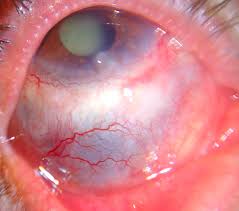Hawaii Ophthalmological Society Speaking Event
 In the Spring of 2016, I, along with a board certified ophthalmologist, gave a talk at the annual Hawaii Ophthalmological Society meeting. The Hawaii Ophthalmological Society is a group of distinguished eye surgeons based in Hawaii that meet and collaborate to enhance the quality of patient care in the state of Hawaii. We presented a case study of postoperative necrotizing scleritis. Postoperative necrotizing scleritis is an aggressive infection caused by a bacterial infection that typically manifests after intra-ocular or topologically abrasive ocular surgeries. (Pictured right: notice the usually white area called the sclera has darkened patches, indicative of decay. Redness indicates inflammation). This type of infection results in the rapid decomposition of scleral tissue (white part of the eye) and is extremely painful. If this infection is left untreated, a patient faces loss of sight. The presenting ophthalmologist had treated the patient in the case study. After she performed a pterygium excision the patient reported back with severe pain and subsequently was diagnosed with a case of postoperative necrotizing scleritis. (A pterygium is a protein growth on top of the cornea, partly due to overexposure to UV radiation). Please see this study for more information on the role UV light exposure has on pterygium development (Hint: please, wear sunglasses!).
In the Spring of 2016, I, along with a board certified ophthalmologist, gave a talk at the annual Hawaii Ophthalmological Society meeting. The Hawaii Ophthalmological Society is a group of distinguished eye surgeons based in Hawaii that meet and collaborate to enhance the quality of patient care in the state of Hawaii. We presented a case study of postoperative necrotizing scleritis. Postoperative necrotizing scleritis is an aggressive infection caused by a bacterial infection that typically manifests after intra-ocular or topologically abrasive ocular surgeries. (Pictured right: notice the usually white area called the sclera has darkened patches, indicative of decay. Redness indicates inflammation). This type of infection results in the rapid decomposition of scleral tissue (white part of the eye) and is extremely painful. If this infection is left untreated, a patient faces loss of sight. The presenting ophthalmologist had treated the patient in the case study. After she performed a pterygium excision the patient reported back with severe pain and subsequently was diagnosed with a case of postoperative necrotizing scleritis. (A pterygium is a protein growth on top of the cornea, partly due to overexposure to UV radiation). Please see this study for more information on the role UV light exposure has on pterygium development (Hint: please, wear sunglasses!).
I had been shadowing this ophthalmologist for approximately six months prior to this talk and had been slowly accumulating a knowledge database of medical jargon that prepared me to feel comfortable giving such a talk in front of many of Hawaii’s distinguished ophthalmologists. Preparation for this talk involved me reading research published in medical journals and reviewing the findings with my supervising ophthalmologist. This preparation proceeded for approximately three months leading up to the talk. During this preparation time, we also rehearsed our talk once a week. In terms of my speaking role at the event, the ophthalmologist that I was shadowing allowed me 50% of speaking time. After she presented the case study and her recommendations, prognosis, and treatment, I was allowed to brief the audience on (1) What is post operative necrotising scleritis, (2) Present the research and findings from various case studies, and (3) Present a comparative analysis between the treatment options (ours vs. research findings).
This experience was one of the most intimidating, by far. I recall being extremely anxious and doubtful in myself regarding my capability of (1) Comprehending professional medical studies and (2) constructing a relevant and engaging presentation to a group of ophthalmological professionals. To combat these doubts, I engaged further into my readings and reached out to my supervising ophthalmologist when I had questions. When I felt nervous, I practiced my speaking role even more.
Overall, this experience required me to practice reaching out to others when I need help, manage my time wisely, and conduct research on my own. I imagine that these traits will help me drastically in graduate school and my future career.
The name of the supervising physician is omitted. Please contact me for further questions. Along with the above article about pterygium and UV radiation, here is another study on postoperative necrotizing scleritis (Disclaimer, it’s not pretty!). Please, do what you can to protect your eyes!
Copyright notice: All images used (summary image and image above) are licensed under a Creative Commons License. Image links are below. Summary picture and Necrotizing Scleritis picture